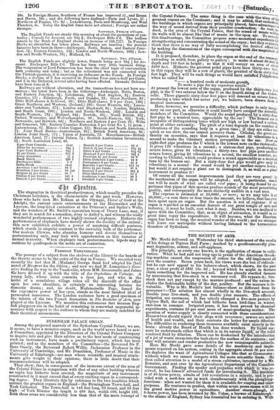SYDENHAM PALACE ORGAN.
Among the projected marvels of the Sydenham Crystal Palace, we are, it seems, to have a monster-organ, such as the world never heard or saw. A Committee, appointed by the Directors of the Crystal Palace Company to inquire into and give their advice as to the best mode of constructing such an instrument, have made a preliminary report, which has been printed ; and as the members of the Committee—the Reverend Sir F. Gore Ousely, the Reverend Robert Willis, Jacksonian Professor in the University of Cambridge, and Mr. Donaldson, Professor of Music in the University of Edinburgh—are men whose scientific and musical attain- ments give weight to their opinions, there is little doubt that their recommendations will be adopted. They show, that, in consequence of the immense extent of the area of the Crystal Palace in comparison with that of any other building wherein an organ has hitherto been erected, the magnitude of any instrument constructed in it must exceed that of every existing organ in a correspond- ing degree. They illustrate this by reference to the two localities which contain the greatest organs in England—the Birmingham Town-hall, and York Cathedral. The Town-hall is 145 feet long, 65 broad, and 65 feet high : of York Minster the length is 486 feet, width 100, height 102. Both thew areas are considerably leas than that of the mere transept of
rthe Crystal Palace. The same thing is the case with the sites ne—th„ greatest organs on the Continent ; and it may be added, that cathedral; the- buildings in which organs are principally placed, haveadvantagea Th." the way of sound derived from their peculiar construction. So vast, deed, is the area of the Crystal Palace, that the sound of music wn its walls will be almost like that of music in the open air. To Tema; this disadvantage, the Committee propose some acoustical expedients ea'r strengthening and concentrating the sound of the organ ; but they evide,tly. think that there is no way of fully accomplishing the desired effeethit by making the dimensions of the organ correspond with the magnitude of the building.
It is proposed, therefore, to place the organ at the end of the trareteg, extending in width from gallery to gallery • to make it about 60 feet in depth and 140 feet in height ; so that it ;till occupy an area of about 5400 feet. Hitherto the greatest pedal pipes have been thirty-two feet; in this organ they will be a row of giants, the greatest of them sixty.foat feet high. They will be such things as would have added Polyphemus when he called for
"— a hundred reeds of moderate 8rev4tb1
To make a pipe for my capacious mouth.' At present the lowest note of the organ, produced by the thirty-two feet pipe, is the C two octaves below the C on the fourth string of the vielon. cello. These gigantic sixty-four feet pipes will descend an octave lover, producing a tone which has never yet, we believe, been drawn from a musical instrument.
Here, however' we perceive a difficulty, which perhaps is only imagi. nary on our part, as otherwise it could hardly have escaped the scierdific members of the Committee. Would the sound produced by a sixty-fear feet pipe be a musical tone, appreciable by the ear ? The human ear is incapable of distinguishing tones which are high or low beyond a certain point at either extremity. The pitch of a tone depends on the number of vibrations of the sounding body in a given time; - if they ere either too quick or too slow, the ear cannot perceive them. Chladni the great au- thority on acoustics, says that it requires at least 32 iihrations in a second to make the vibratory motion perceptible to the ear. Now an eight-feet pipe produces the C which is the lowest note on the violoncello. It gives 128 vibrations in a second; a sixteen-feet pipe, producing an octave lower, gives 64 vibrations ; a thirty-two feet pipe goes another octave lower, giving 32 vibrations in a second, the smallest number, ac- cording to Chladni, which could produce a sound appreciable as a musical tone by the human ear. But a sixty-four feet pipe would give only 16 vibrations in a second : the sound would be yet another octave lower; but would it not require a giant ear to distinguish it, as well as a giant instrument to produce it ?
Of course all the recent improvements (and they are vely great) in the mechanism of the organ will be adopted ; and, in particular, much use will be made of what are called reed pipes; it being- found by ex- perience that pipes-of this species produce sounds of the most penetrating quality, and consequently the most distinctly audible in a vast area. The expense is estimated at 25,000L, or more; so we may take it at 30,000/.,—a sum three or four times the amount, we believe, that has ever been spent upon an organ. But the question is not cif expense : if an organ is regarded as an essential feature of our great temple of arts and industry, it must be built, cost what it may. Besides, we are inelined to agree with the Committee, that, as an object of attraction, it would in no
great time repay the expenditure. It will become, what the Haarlem organ has been so long, the musical wonder of the world ; and no stranger will leave our metropolis without having listened to the harmonious thunders of Sydenham.


































 Previous page
Previous page